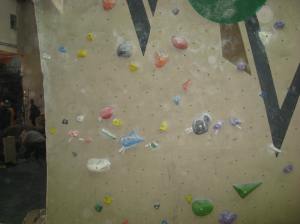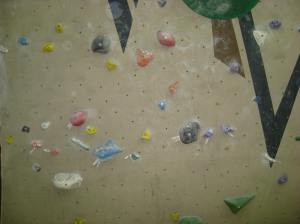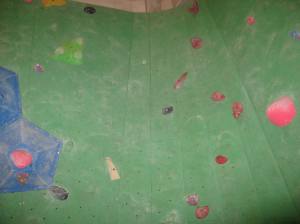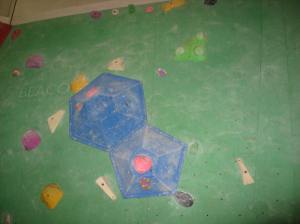Monday 10/11/2014:
I headed to the Mile End Wall with my mind almost in the right mind frame and feeling happy and cheerful even though my heart was elsewhere to climb hard but I did not know what to concentrate on. Do I focus on technique? Do I try to get to the top of problems? Where do I start? My first port of call after stretching and traversing was the slab in the main area to attempt technical problems but the slab was busy with people trying to do the hardest circuit problem there (V6-V8+) so I decided to watch the climbers and ask them for tips once they had finished. After the other climbers finished from the problem I had a few goes myself but even though I knew how to do the move after the footswap I did not have the leg flexibility to get the foot to the other long narrow and flat foot hold close to a edge of the slab – the moves after this looked tricky but do-able. After this problem I saw one of the other climbers climb a V3-V5 circuit problem to the left of the hardest problem so I attempted it myself but after holding on to the big flake side pull and getting my foot on to the small flat circular hold I could not do stand up on that foot to help me get to the big volume hold just after the slabby part of the problem finishes – standing up on that high-ish foothold was what the other climber told me to do – I did not give up as I tried hopping with the other leg and going for a super long reach but nothing worked. I then spotted a V4-V6 overhanging problem that I knew I could do the move that starts by matching hands on a large weird hold (weird pinch? weird bar hold?) the reaching out to medium size crimp on a volume on the wall whilst having one foot on a small hold and flagging with the other. I knew the crimp was there as I had read the sequence but as the move is sidewards one you can not see the hold – such moves are called ‘blind moves’. After the main section I headed to the secret garden to try some of the new problems on the slab there. What I spotted as soon I entered The Secret Garden was a new climbing area which I later was called The Competition Wall, so instead of trying the problems on the slab I found a problem that I liked which had huge holds – slopey but grippy side pulls for holds to start of with and long wide footholds. I tried to problem without reading the sequence and it got me doing a wide bridge but because of the angles of the part of the wall where the problem was it put me off balance. I then read the sequence but decided not to try the problem again. The thing about The Competition Wall is that the problems are ungraded and in terms of difficulty might much the same colored problems in other parts of the centre for example a blue problem there might not be V3-V5 which is the grade of the other problems in that circuit. Strangely enough, I read on a notice on The Competition Wall, that the problems are off-piste which actually is a skiing term. Off-piste skiing is skiing outside the patrolled and marked areas of the resort. I then went to slab area in The Secret garden and attempted a very crimpy V4-V6 circuit problem that involved me pushing on a volume with one hand and with the other hand on a small crimpy sidepull reaching for a small crimp – I got stuck here at every attempt because I forgot to read the sequence. After that problem I gave my fingers a rest and to compare moves I found a VB-V0 minus circuit problem which was very juggy in nature. I found the climbing on this problem very easy and climbed it up to wear I wanted to climb it smoothly and with a good flow. As to the moves themselves they were similar to the V4-V6 problem but easier to execute. Just to compare moves I found a problem in V0minus-V0+ circuit with holds that were not as big as the previous problem’s and gave it a few goes after reading the sequence – I found the climbing to be smooth and with a good flow. I also had a few tries on a V6-V8+ circuit problem where the only starting hand hold was is a weird crimp on a volume where you match hands. What I tried next was try to reach the volumes where two almost invisible crimps were. I tried to do it by putting my body in weird position where one leg was flagging smearing on the adjacent wall. Another climber tried to do get to the crimps by managing to get both feet on the footholds and balancing and balancing then reaching for the crimps – none of us managed to do the problem. Sorry I do not have any photographs. This is due to me not having a camera with me.
Wednesday 12/11/2014:
On Wednesday I headed to the White Spider to work on technique and maybe get some problems done. I decided after stretching and traversing to head to the downstairs slab area for slab technique and to get a slab circuit problem done. My first problem was a V1-V3 problem with large holds including slopers. After the first two moves this problem got me either smearing or flaggng to get to the next sloper but as many times I tried and whatever technique I tried I could not get to that sloper – it was just out of reach. The problem is the orange one – yes the wall is a slab but I took it at that angle to get as many holds in as possible.
 As you can see my photographs are not top quality – I am no David Simmonite or Alex Ekins – but you can see the holds and try to imagine the moves. I am not sue if the last photo is for the mentioned problem or the next one. The next problem I liked the look of was a V4-V6 problem on the same slab – the black ones in the photograph above – that had interesting holds. The first hand hold that you start on with matched hands is a weird large crimp with a side pull attached to it. The first foot hold is a small triangular crimp you pivot on – I am not sue if you can see it on this photo in this size – it lies to the of the big green foot hold. What I did next was transfer the right hand to the side pull and with the left reach for the rough-ish positive sloper and hold it like – not to sound perverted and groper-like – like a woman’s breast in an open-hand form. Then here it gets confusing – do I get my other foot on the very small foot hold then reach for the crimpy jug with the right hand or the other way round i.e. right hand to crimp then left left foot to foot hold? I did it the second way as I found it easier but I kept getting stuck as I kept loosing balance. What needs to be done but can’t anymore – as my good friend Rich ‘Tricky’ Hudson has reset that climbing area – is to flag with the other foot or possibly remove the hand from the sloper and use the arete of the wall to maintain balance. The problem is the black one.
As you can see my photographs are not top quality – I am no David Simmonite or Alex Ekins – but you can see the holds and try to imagine the moves. I am not sue if the last photo is for the mentioned problem or the next one. The next problem I liked the look of was a V4-V6 problem on the same slab – the black ones in the photograph above – that had interesting holds. The first hand hold that you start on with matched hands is a weird large crimp with a side pull attached to it. The first foot hold is a small triangular crimp you pivot on – I am not sue if you can see it on this photo in this size – it lies to the of the big green foot hold. What I did next was transfer the right hand to the side pull and with the left reach for the rough-ish positive sloper and hold it like – not to sound perverted and groper-like – like a woman’s breast in an open-hand form. Then here it gets confusing – do I get my other foot on the very small foot hold then reach for the crimpy jug with the right hand or the other way round i.e. right hand to crimp then left left foot to foot hold? I did it the second way as I found it easier but I kept getting stuck as I kept loosing balance. What needs to be done but can’t anymore – as my good friend Rich ‘Tricky’ Hudson has reset that climbing area – is to flag with the other foot or possibly remove the hand from the sloper and use the arete of the wall to maintain balance. The problem is the black one.

 The other problems on this wall that looked interesting were the V5-V8 white circuit problem and the light blue circuit ones ( I cannot remember the grade). I did not want to attempt these because they looked if they involved some kind of pushing movement which I am not yet conditioned for.
The other problems on this wall that looked interesting were the V5-V8 white circuit problem and the light blue circuit ones ( I cannot remember the grade). I did not want to attempt these because they looked if they involved some kind of pushing movement which I am not yet conditioned for.
Friday 14/11/2014:
On a diversion from my usual Friday climbing venue of The Castle I went to The Westways to see if it was quiet and less busy on a Friday afternoons than Wednesday ones – and it was. After stretches and traversing I went to the V3-V5 circuit problem that involved foot and hand matching and pushing down. I tried it several times and each time I tried to lean in the opposite direction of the hold I wanted to get my foot on but every time I could not get it high enough – I think the huge sloper hold would not allow me to lean to the left. The problem is the yellow one – you can see the massive sloper hold very well on this photo. The left foot was standing on a very small hold – but you can’t see it on any of my photos. The other big problem that I found was that pushing down on the juggy sloper – the hold where I needed to get my foot on – hurt my hand as you can see most of it from the first photo has got a sharp-ish bit to it, so imagine pushing down on that hold.


 The next problem I tried was a pink circuit problem – I do not remember the grade band for this circuit – in the same slab area as the V3-V5 problem, you can see some of the holds in the above photograph. The first hand holds were and first foot hold were very tiny crimps and the as you can see from the above photo I had to a big reach to the strange sloper crimp on the blue volume and I managed to it but I could not hold onto the hold due to a lack of grip strength and/or balance – what I think I needed to do and will do next time is flag with the other leg. The last problem I had a few goes on was a black V4-V6 circuit problem, I managed to hold the hand holds correctly and stand on the first foot hold correctly but I I found it hard to get my other foot on the second foot hold and out of all the tries on this problem I only managed to get the foot on once.
The next problem I tried was a pink circuit problem – I do not remember the grade band for this circuit – in the same slab area as the V3-V5 problem, you can see some of the holds in the above photograph. The first hand holds were and first foot hold were very tiny crimps and the as you can see from the above photo I had to a big reach to the strange sloper crimp on the blue volume and I managed to it but I could not hold onto the hold due to a lack of grip strength and/or balance – what I think I needed to do and will do next time is flag with the other leg. The last problem I had a few goes on was a black V4-V6 circuit problem, I managed to hold the hand holds correctly and stand on the first foot hold correctly but I I found it hard to get my other foot on the second foot hold and out of all the tries on this problem I only managed to get the foot on once.





 Note: Some photos may look the same but they are displaying different problems
Note: Some photos may look the same but they are displaying different problems

